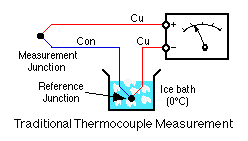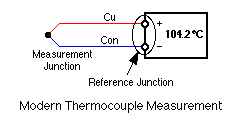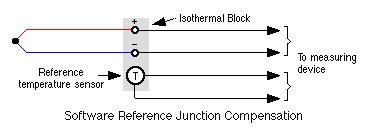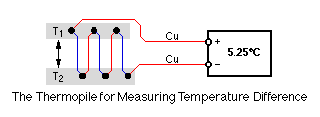Introduction to Thermocouples
The thermocouple is one of the simplest of all sensors. It consists of two wires of dissimilar metals joined near the measurement point. The output is a small voltage measured between the two wires.

While appealingly simple in concept, the theory behind the thermocouple is subtle, the basics of which need to be understood for the most effective use of the sensor.
Thermocouple theory
A thermocouple circuit has at least two junctions: the measurement junction and a reference junction. Typically, the reference junction is created where the two wires connect to the measuring device. This second junction it is really two junctions: one for each of the two wires, but because they are assumed to be at the same temperature (isothermal) they are considered as one (thermal) junction. It is the point where the metals change - from the thermocouple metals to what ever metals are used in the measuring device - typically copper.
The output voltage is related to the temperature difference between the measurement and the reference junctions. This is phenomena is known as the Seebeck effect. The Seebeck effect generates a small voltage along the length of a wire, and is greatest where the temperature gradient is greatest. If the circuit is of wire of identical material, then they will generate identical but opposite Seebeck voltages which will cancel. However, if the wire metals are different the Seebeck voltages will be different and will not cancel.
In practice the Seebeck voltage is made up of two components: the Peltier voltage generated at the junctions, plus the Thomson voltage generated in the wires by the temperature gradient.

The Peltier voltage is proportional to the temperature of each junction while the Thomson voltage is proportional to the square of the temperature difference between the two junctions. It is the Thomson voltage that accounts for most of the observed voltage and non-linearity in thermocouple response.
Each thermocouple type has its characteristic Seebeck voltage curve. The curve is dependent on the metals, their purity, their homogeneity and their crystal structure. In the case of alloys, the ratio of constituents and their distribution in the wire is also important. These potential inhomogeneous characteristics of metal are why thick wire thermocouples can be more accurate in high temperature applications, when the thermocouple metals and their impurities become more mobile by diffusion.
The practical considerations of thermocouples
The above theory of thermocouple operation has important practical implications that are well worth understanding:
1. A third metal may be introduced into a thermocouple circuit and have no impact, provided that both ends are at the same temperature. This means that the thermocouple measurement junction may be soldered, brazed or welded without affecting the thermocouple's calibration, as long as there is no net temperature gradient along the third metal.
Further, if the measuring circuit metal (usually copper) is different to that of the thermocouple, then provided the temperature of the two connecting terminals is the same and known, the reading will not be affected by the presence of copper.
2. The thermocouple's output is generated by the temperature gradient along the wires and not at the junctions as is commonly believed. Therefore it is important that the quality of the wire be maintained where temperature gradients exists. Wire quality can be compromised by contamination from its operating environment and the insulating material. For temperatures below 400°C, contamination of insulated wires is generally not a problem. At temperatures above 1000°C, the choice of insulation and sheath materials, as well as the wire thickness, become critical to the calibration stability of the thermocouple.
The fact that a thermocouple's output is not generated at the junction should redirect attention to other potential problem areas.
3. The voltage generated by a thermocouple is a function of the temperature difference between the measurement and reference junctions. Traditionally the reference junction was held at 0°C by an ice bath:

The ice bath is now considered impractical and is replace by a reference junction compensation arrangement. This can be accomplished by measuring the reference junction temperature with an alternate temperature sensor (typically an RTD or thermistor) and applying a correcting voltage to the measured thermocouple voltage before scaling to temperature.

The correction can be done electrically in hardware or mathematically in software. The software method is preferred as it is universal to all thermocouple types (provided the characteristics are known) and it allows for the correction of the small non-linearity over the reference temperature range.
4. The low-level output from thermocouples (typically 50mV full scale) requires that care be taken to avoid electrical interference from motors, power cable, transformers and radio signal pickup. Twisting the thermocouple wire pair (say 1 twist per 10 cm) can greatly reduce magnetic field pickup. Using shielded cable or running wires in metal conduit can reduce electric field pickup. The measuring device should provide signal filtering, either in hardware or by software, with strong rejection of the line frequency (50/60 Hz) and its harmonics.
5. The operating environment of the thermocouple needs to be considered. Exposure to oxidizing or reducing atmospheres at high temperature can significantly degrade some thermocouples. Thermocouples containing rhodium (B, R and S types) are not suitable under neutron radiation.
The advantages and disadvantages of thermocouples
Because of their physical characteristics, thermocouples are the preferred method of temperature measurement in many applications. They can be very rugged, are immune to shock and vibration, are useful over a wide temperature range, are simple to manufactured, require no excitation power, there is no self heating and they can be made very small. No other temperature sensor provides this degree of versatility.
Thermocouples are wonderful sensors to experiment with because of their robustness, wide temperature range and unique properties.
On the down side, the thermocouple produces a relative low output signal that is non-linear. These characteristics require a sensitive and stable measuring device that is able provide reference junction compensation and linearization. Also the low signal level demands that a higher level of care be taken when installing to minimise potential noise sources.
The measuring hardware requires good noise rejection capability. Ground loops can be a problem with non-isolated systems, unless the common mode range and rejection is adequate.
Types of thermocouple
About 13 'standard' thermocouple types are commonly used. Eight have been given an internationally recognised letter type designators. The letter type designator refers to the emf table, not the composition of the metals - so any thermocouple that matches the emf table within the defined tolerances may receive that table's letter designator.
Some of the non-recognised thermocouples may excel in particular niche applications and have gained a degree of acceptance for this reason, as well as due to effective marketing by the alloy manufacturer. Some of these have been given letter type designators by their manufacturers that have been partially accepted by industry.
Each thermocouple type has characteristics that can be matched to applications. Industry generally prefers K and N types because of their suitability to high temperatures, while others often prefer the T type due to its sensitivity, low cost and ease of use.
A table of standard thermocouple types is presented below. The table also shows the temperature range for extension grade wire in brackets.
|
Type
|
Positive Material
|
Negative Material
|
Accuracy*** |
Range °C |
Comments
|
|
B
|
Pt, 30%Rh
|
Pt, 6%Rh
|
0.5% |
50 to 1820 |
Good at high temperatures, no reference junction compensation required.
|
|
C**
|
W, 5%Re
|
W, 26%Re
|
1% |
0 to 2315 |
Very high temperature use, brittle
|
|
D**
|
W, 3%Re
|
W, 25%Re
|
1% |
0 to 2315 |
Very high temperature use, brittle
|
|
E
|
Ni, 10%Cr
|
Cu, 45%Ni
|
0.5% or 1.7°C
|
-270 to 1000 |
General purpose, low and medium temperatures
|
|
G**
|
W
|
W, 26%Re
|
1% |
0 to 2315 |
Very high temperature use, brittle
|
|
J
|
Fe
|
Cu, 45%Ni
|
0.75% or 2.2°C
|
-210 to 1200 |
High temperature, reducing environment
|
|
K*
|
Ni, 10%Cr
|
Ni, 2%Al |
0.75% or 2.2°C
|
-270 to 1372 |
General purpose high temperature, oxidizing environment
|
|
L**
|
Fe
|
Cu, 45%Ni
|
0.4% or 1.5°C
|
0 to 900
|
Similar to J type. Obsolete - not for new designs
|
|
M**
|
Ni
|
Ni, 18%Mo
|
0.75% or 2.2°C
|
-50 to 1410
|
.
|
|
N*
|
Ni, 14%Cr |
Ni, |
0.75% or 2.2°C
|
-270 to 1300 |
Relatively new type as a superior replacement for K Type.
|
|
P**
|
Platinel II
|
Platinel II
|
1.0%
|
0 to 1395
|
A more stable but expensive substitute for K & N types
|
|
R
|
Pt, 13%Rh
|
Pt
|
0.25% or 1.5°C
|
-50 to 1768 |
Precision, high temperature
|
|
S
|
Pt, 10%Rh
|
Pt
|
0.25% or 1.5°C
|
-50 to 1768 |
Precision, high temperature
|
|
T*
|
Cu
|
Cu, 45%Ni
|
0.75% or 1.0°C
|
-270 to 400 |
Good general purpose, low temperature, tolerant to moisture.
|
|
U**
|
Cu
|
Cu, 45%Ni
|
0.4% or 1.5°C
|
0 to 600
|
Similar to T type. Obsolete - not for new designs
|
|
* Most commonly used thermocouple types, ** Not ANSI recognized types. *** See IEC 584-2 for more details. Materials codes:- Al = Aluminum, Cr = Chromium, Cu = Copper, Mg = Magnesium, Mo = Molybdenum, Ni = Nickel, Pt = Platinum, Re = Rhenium, Rh = Rhodium, Si = Silicon, W = Tungsten
| |||||
Accuracy of thermocouples
Thermocouples will function over a wide temperature range - from near absolute zero to their melting point, however they are normally only characterized over their stable range. Thermocouple accuracy is a difficult subject due to a range of factors. In principal and in practice a thermocouple can achieve excellent results (that is, significantly better than the above table indicates) if calibrated, used well below its nominal upper temperature limit and if protected from harsh atmospheres. At higher temperatures it is often better to use a heavier gauge of wire in order to maintain stability (Wire Gauge below).
As mentioned previously, the temperature and voltage scales were redefined in 1990. The eight main thermocouple types - B, E, J, K, N, R, S and T - were re-characterised in 1993 to reflect the scale changes. (See: NIST Monograph 175 for details). The remaining types: C, D, G, L, M, P and U appear to have been informally re-characterised.
Try the thermocouple calculator. It allows you the determine the temperature by knowing the measured voltage and the reference junction temperature.
There are different grades of thermocouple wire. The principal divisions are between measurement grades and extension grades. The measurement grade has the highest purity and should be used where the temperature gradient is significant. The standard measurement grade (Class 2) is most commonly used. Special measurement grades (Class 1) are available with accuracy about twice the standard measurement grades.
The extension thermocouple wire grades are designed for connecting the thermocouple to the measuring device. The extension wire may be of different metals to the measurement grade, but are chosen to have a matching response over a much reduced temperature range - typically -40°C to 120°C. The reason for using extension wire is reduced cost - they can be 20% to 30% of the cost of equivalent measurement grades. Further cost savings are possible by using thinner gauge extension wire and a lower temperature rated insulation.
Note: When temperatures within the extension wire's rating are being measured, it is OK to use the extension wire for the entire circuit. This is frequently done with T type extension wire, which is accurate over the -60 to 100°C range.
At high temperatures, thermocouple wire can under go irreversible changes in the form of modified crystal structure, selective migration of alloy components and chemical changes originating from the surface metal reacting to the surrounding environment. With some types, mechanical stress and cycling can also induce changes.
Increasing the diameter of the wire where it is exposed to the high temperatures can reduce the impact of these effects.
The following table can be used as a very approximate guide to wire gauge:
|
Type
|
8 Gauge |
16 Gauge |
20 Gauge |
24 Gauge |
28 Gauge |
30 Gauge |
|
B
|
1820
|
-
|
-
|
1700
|
1700
|
-
|
|
C
|
2315
|
2315
|
2315
|
2315
|
2315
|
-
|
|
D
|
2315
|
2315
|
2315
|
2315
|
2000
|
-
|
|
E
|
870
|
620
|
540
|
430
|
400
|
370
|
|
G
|
2315
|
2315
|
2315
|
2315
|
2315
|
-
|
|
J
|
760
|
560
|
480
|
370
|
370
|
320
|
|
K
|
1260*
|
1000*
|
980
|
870
|
820
|
760
|
|
M
|
1260*
|
1200*
|
-
|
-
|
-
|
-
|
|
N
|
1260*
|
1000*
|
980
|
870
|
820
|
760
|
|
P
|
1395
|
-
|
1250
|
1250
|
1250
|
-
|
|
R
|
1760
|
-
|
-
|
1480
|
1480
|
-
|
|
S
|
1760
|
-
|
-
|
1480
|
1480
|
-
|
|
T
|
400
|
370
|
260
|
200
|
200
|
150
|
|
* Upper temperature limits only apply in a protective sheath
| ||||||
At these higher temperatures, the thermocouple wire should be protected as much as possible from hostile gases. Reducing or oxidizing gases can corrode some thermocouple wire very quickly. Remember, the purity of the thermocouple wire is most important where the temperature gradients are greatest. It is with this part of the thermocouple wiring where the most care must be taken.
Other sources of wire contamination include the mineral packing material and the protective metal sheath. Metallic vapour diffusion can be significant problem at high temperatures. Platinum wires should only be used inside a nonmetallic sheath, such as high-purity alumna.
Neutron radiation (as in a nuclear reactor) can have significant permanent impact on the thermocouple calibration. This is due to the transformation of metals to different elements.
High temperature measurement is very difficult in some situations. In preference, use non-contact methods. However this is not always possible, as the site of temperature measurement is not always visible to these types of sensors.
Colour coding of thermocouple wire
The colour coding of thermocouple wire is something of a nightmare! There are at least seven different standards. There are some inconsistencies between standards, which seem to have been designed to confuse. For example the colour red in the USA standard is always used for the negative lead, while in German and Japanese standards it is always the positive lead. The British, French and International standards avoid the use of red entirely!
There are four common ways in which thermocouples are mounted with in a stainless steel or Inconel sheath and electrically insulated with mineral oxides. Each of the methods has its advantages and disadvantages.

Sealed and Isolated from Sheath: Good relatively trouble-free arrangement. The principal reason for not using this arrangement for all applications is its sluggish response time - the typical time constant is 75 seconds
Sealed and Grounded to Sheath: Can cause ground loops and other noise injection, but provides a reasonable time constant (40 seconds) and a sealed enclosure.
Exposed Bead: Faster response time constant (typically 15 seconds), but lacks mechanical and chemical protection, and electrical isolation from material being measured. The porous insulating mineral oxides must be sealed
Exposed Fast Response: Fastest response time constant, typically 2 seconds but with fine gauge of junction wire the time constant can be 10-100 ms. In addition to problems of the exposed bead type, the protruding and light construction makes the thermocouple more prone to physical damage.
Thermocouple compensation and linearization
As mentioned above, it is possible to provide reference junction compensation in hardware or in software. The principal is the same in both cases: adding a correction voltage to the thermocouple output voltage, proportional to the reference junction temperature. To this end, the connection point of the thermocouple wires to the measuring device (i.e. where the thermocouple materials change to the copper of the circuit electronics) must be monitored by a sensor. This area must be design to be isothermal, so that the sensor accurately tracks both reference junction temperatures.
The hardware solution is simple but not always as easy to implement as one might expect.

The circuit needs to be designed for a specific thermocouple type and hence lacks the flexibility of the software approach.
The software compensation technique simplifies the hardware requirement, by eliminating the reference sensor amplifier and summing circuit (although a multiplexer may be required).

The software algorithm to process the signals needs to be carefully written. A sample algorithm details the process.
A good resource for thermocouple emf tables and coefficients is at the US Commerce Dept's NIST web site. It covers the B, E, J, K, N, R, S and T types.
The thermocouple as a heat pump
The thermocouple can function in reverse. If a current is passed through a thermocouple circuit, one junction will cool and the other warm. This is known as the Peltier Effect and is used in small cooling systems. The effect can be demonstrated by alternately passing a current through a thermocouple circuit and then quickly measuring the circuit's Seebeck voltage. This process has been used, with very fine thermocouple wire (0.025 mm with about a 10 mA current), to measure humidity by ensuring the cooled junction drops below the air's dew point. This causes condensation to form on the cooled junction. The junction is allowed to return to ambient, with the temperature curve showing an inflection at the dew point caused by the latent heat of vaporization.
Measuring temperature differences
Thermocouples are excellent for measuring temperatures differences, such as the wet bulb depression in measuring humidity. Sensitivity can be enhanced by constructing a thermopile - a number of thermocouple circuits in series.

In the above example, the thermopile output is proportional to the temperature difference T1 - T2, with a sensitivity three times that of a single junction pair. In practice, thermopiles with two to hundreds of junctions are used in radiometers, heat flux sensors, flow sensors and humidity sensors. The thermocouple materials can be in wire form, but also printed or etched as foils and even electroplated.
The thermocouple is unique in its ability to directly measure a temperature difference. Other sensor types require a pair of closely matched sensors to ensure tracking over the entire operational temperature range.
The thermoelectric generator
While the Seebeck voltage is very small (in the order of 10-70µV/°C), if the circuit's electrical resistance is low (thick, short wires), then large currents are possible (e.g. many amperes). An efficiency trade-off of electrical resistance (as small as possible) and thermal resistance (as large as possible) between the junctions is the major issue. Generally, electrical and thermal resistances trend together with different materials. The output voltage can be increased by wiring as a thermopile.
The thermoelectric generator has found its best-known application as the power source in some spacecraft. A radioactive material, such as plutonium, generates heat and cooling is provided by heat radiation into space. Such an atomic power source can reliably provide many tens of watts of power for years. The fact that atomic generators are highly radioactive prevents their wider application.
